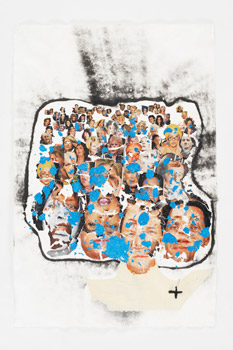2011 Annual Fall Exhibiton
September 30–October 22, 2011
Artist Talk with Jon Kessler Wednesday, October 26, 6:30 pm CSB room 117
Civic Square
33 Livingston Avenue
New Brunswick, NJ 08901
www.masongross.rutgers.edu/performing-arts-center/galleries
The “culture industry” is a term applied in the 1940s by Frankfurt School theorists Theodor Adorno and Max Horkheimer to the fusion of television, radio, film, and advertising. Their essays “The Culture Industry: Enlightenment as Mass Deception” and “The Culture Industry Reconsidered” emphasize consumers’ inability to distinguish advertisement and entertainment from reality. Consumers, in their account, tend to seek pleasure as a means to escape reality instead of developing ways of thinking that resist manipulation by the culture industry. Adorno and Horkheimer observe:
The consumers are the workers and employees, the farmers and lower middle class. Capitalistic production so confines them, body and soul, that they fall helpless victims to what is offered them… the deceived masses are today captivated by the myth of success even more than the successful are. Immovably, they insist on the very ideology which enslaves them.
—Dialectic of Enlightenment (1969)
Through the filter of the culture industry, art has been reduced to crafty techniques that are easily consumed by the mass public. The culture industry’s ability to strip meaning from traditional art forms stems from processes of mechanical (re)production. In “The Culture Industry Reconsidered,” Adorno borrows from Frankfurt School colleague Walter Benjamin, adopting his term “aura”—the sacred and authentic distance that characterizes traditional art before mass reproduction—to point out that in the decay of the “aura” is where culture industry steals its style and conceals its deceptive ideologies as a form of social control.
Consider The Pictures Generation (1974–1984), a generation of artists that witnessed and experienced after-affects of post-World War II America, Vietnam War and The Watergate Scandal when the media culture of movies, televisions, popular music and magazines was creating a sea of pictures that seduce us into consumerism and shape our ideas about gender, race, sexuality and citizenship. This generation expressed a resistance against mass media imagery by investigating how pictures achieve power over masses.
—The Pictures Generation, Douglas Eklund, Metropolitan Museum of Art (2009)
Twenty-five years from now another generation of artists that have experienced The War on Terrorism, The USA PATRIOT Act and the Global Debt Crisis, will find themselves in a similar conflict as The Pictures Generation. How will newly developed social network technologies such as youtube, vimeo, myspace, facebook and twitter play a role in the fabric of our social conscience? How will these events be programmed in our cultural-memory? How will information be disseminated through future artistic practices?
In his seminal essay, “The work of Art in the Age of Mechanical Reproduction” (1936), Benjamin argues that with the destruction of “aura” art is no longer based on ritual but on politics. Frankfurt School theorists believed that artists should not play a subordinate role to the culture industry; rather, as cultural agents, artists should function within and transform representations in the culture industry for purposes of positive social change.
In the exhibition Mass Distractions and Cultural Decay, more than 150 artists deploy strategies and techniques that counter and subvert culture industry ideologies that promote racism, classism, nationalism, militarism, sexism, imperialism, colonialism, and consumerism.
Artists featured in Mass Distractions and Cultural Decay will include: Michael Paul Britto, Brian Bulfer, Heather Bursch, Damian Catera, Crystal Z. Campbell, Taeyoon Choi, Raphael Dallaporta, Emory Douglas, Sam Durant, Sarah Eliassen, Hasan Elahi, Andrea Fraser, Harun Farocki, Nate Harrison, Marc Handelman, Akintola Hanif, Jacqueline Hoang Nguyen, Sean Hovendick, Jon Kessler, Ardele Lister, Amanda Matles, Laura Mulvey, Remembering Olive Collective, Wanda Raimundi-Ortiz, Martha Rosler, Ivor Shearer, Scott Thode, Shane Whilden, Hank Willis Thomas and Jasiri X.
Mass Distractions and Cultural Decay was curated by LaToya Ruby Frazier, Associate Curator.
The Mason Gross Galleries at Civic Square, 33 Livingston Avenue, New Brunswick, NJ 08901 are open from 10 a.m. to 4 p.m. Mondays, Tuesdays, Thursdays and Fridays, 10 a.m. to 6 p.m. Wednesdays and noon to 4 p.m. Saturdays. More information is available by calling 732-932-2222, ext. 798. Admission is free.
